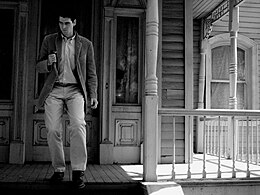24 Hour Psycho
24 Hour Psycho
Video installation by Douglas Gordon , 1993
video cassette, video recorder, video projector, semi-transparent screen (300 × 400 cm or 400 × 600 cm)
24 Hour Psycho is a video installation by Scottish artist Douglas Gordon from 1993, in which he extends the classic film Psycho by Alfred Hitchcock to a playback length of 24 hours. He uses a standard video cassette of the film, a video recorder with continuously variable playback speed, a video projector and a semi-transparent screen (300 × 400 cm or 400 × 600 cm). The entire installation takes up a space of at least 5.2 m × 14 m × 7 m.
Description and interpretation
In his work, he expands a video of Alfred Hitchcock's 1960 film classic Psycho from an original length of 109 minutes to a duration of 24 hours and presents the result on a free-standing room installation. The viewer has to look for an optimal position in front of the screen and inevitably appears as a shadow in the projection. In contrast to celluloid film, video as a medium does not result in breaks between the individual images; instead, the images flow very slowly into one another.
Due to the very strong stretching of the film material, the images on the screen change only very slowly and the impression of a slowly changing still image is created, the sound cannot be identified. The audience, who are usually familiar with the classic film, thinks their way into the scene and thinks about it further to complete it, without the image content changing. In this way, the past in the form of the previous scenes, the present in the form of the still image and the future in the form of the further projected content are mixed and condensed when viewed.
Classification in the work of the artist
The artist Douglas Gordon became known at his first exhibitions in 1993 through his work 24 Hours Psycho . Since then, his interest in the alienation of cinema icons has determined his oeuvre: In 1998 the idea of extending The Searchers by John Ford from 1956 to the duration of the film's plot of 5 years (5 year drive by) was born . It was partially realized on location of the film, in the desert of Monument Valley .
In other works, too, the artist makes use of the expanded concept of time and uses existing film material in the form of so-called filmic ready-mades for abstraction. The time factor, together with memories and expectations, are also in the foreground in other works.
Literary reception
For the American writer Don DeLillo , a visit to the video installation in the Museum of Modern Art in New York became the starting point for the novel The Omega Point . In the opening and closing chapters of the novel, he describes the impressions of an observer of the work of art and his reflections on time, movement and perception.
literature
- Twenty Four Hour Psycho. In: Sylvia Martin, Uta Grosenick: Video Art. Taschen GmbH, Cologne 2006; Pp. 52-53. ISBN 978-3-8228-2947-9 .
Web links
Individual evidence
- ↑ Thomas David: End Times in America . In: The World Week of February 25, 2010.
